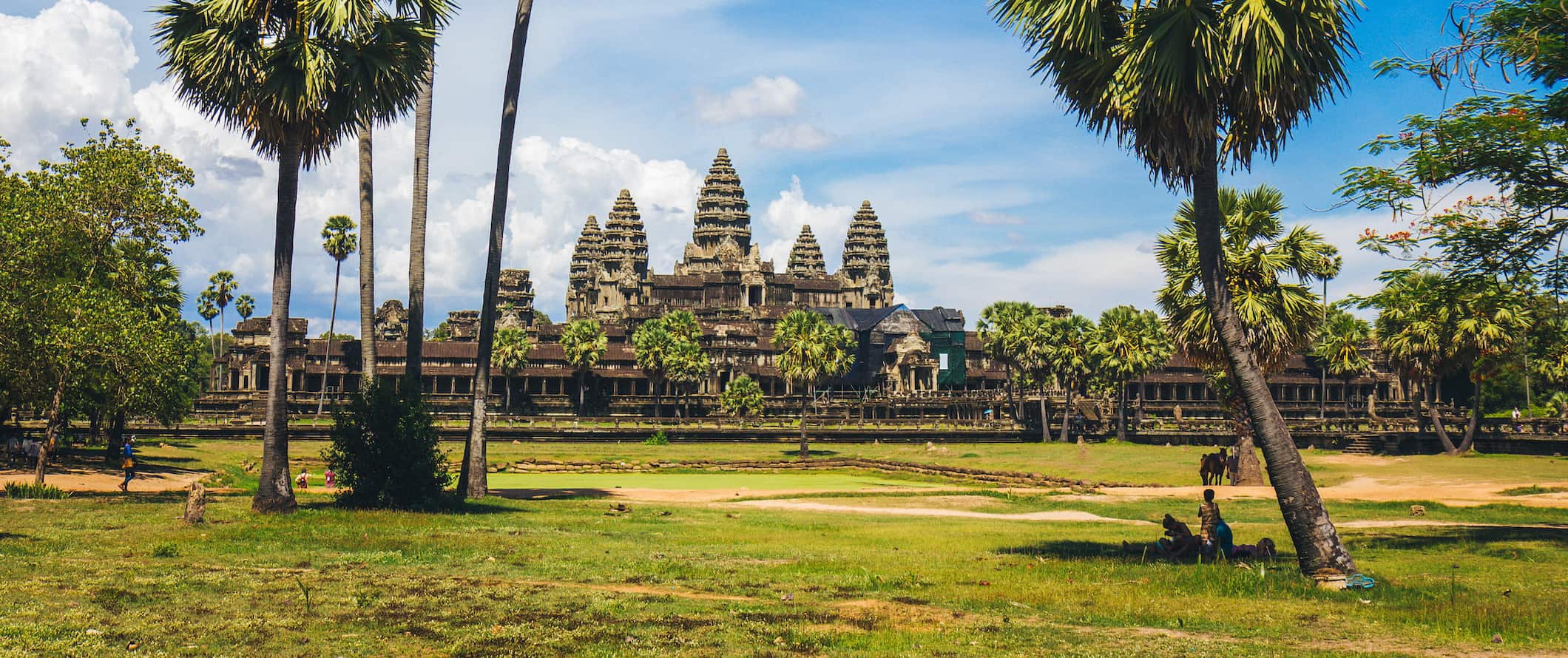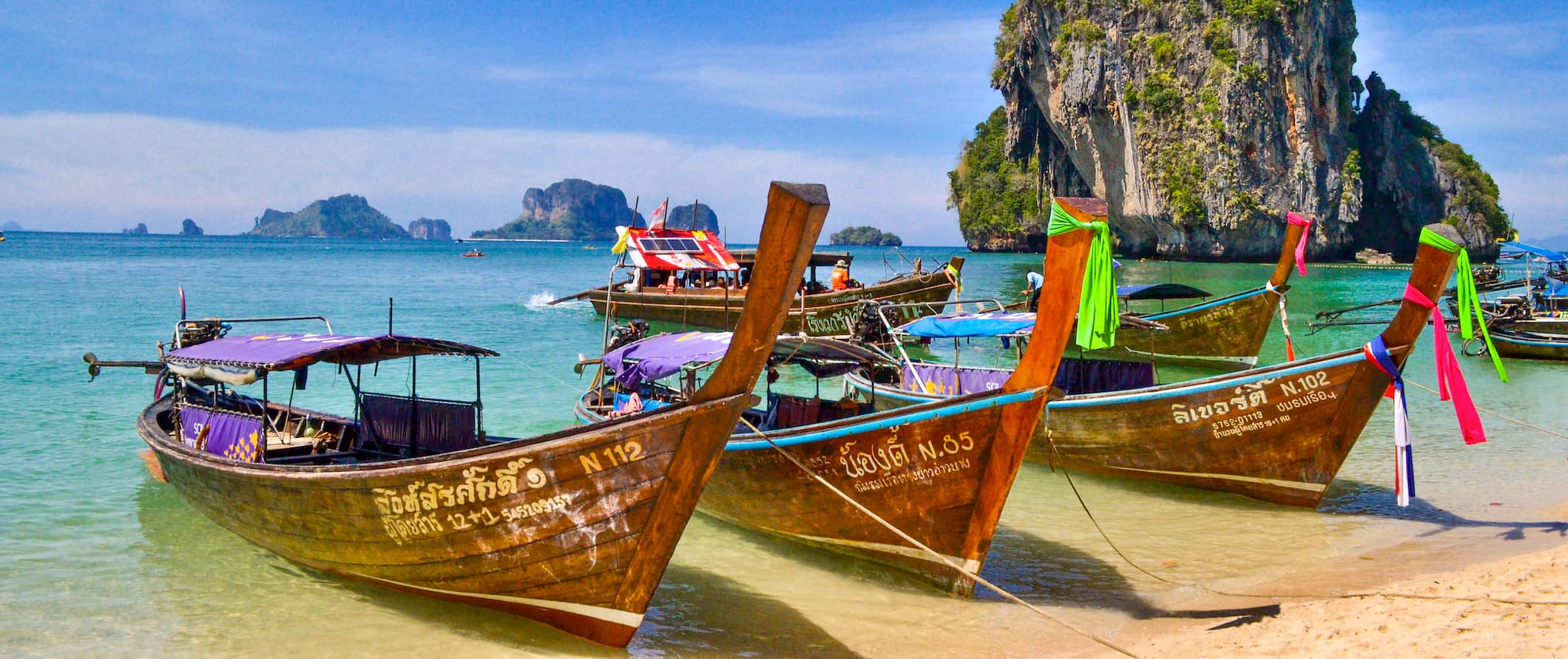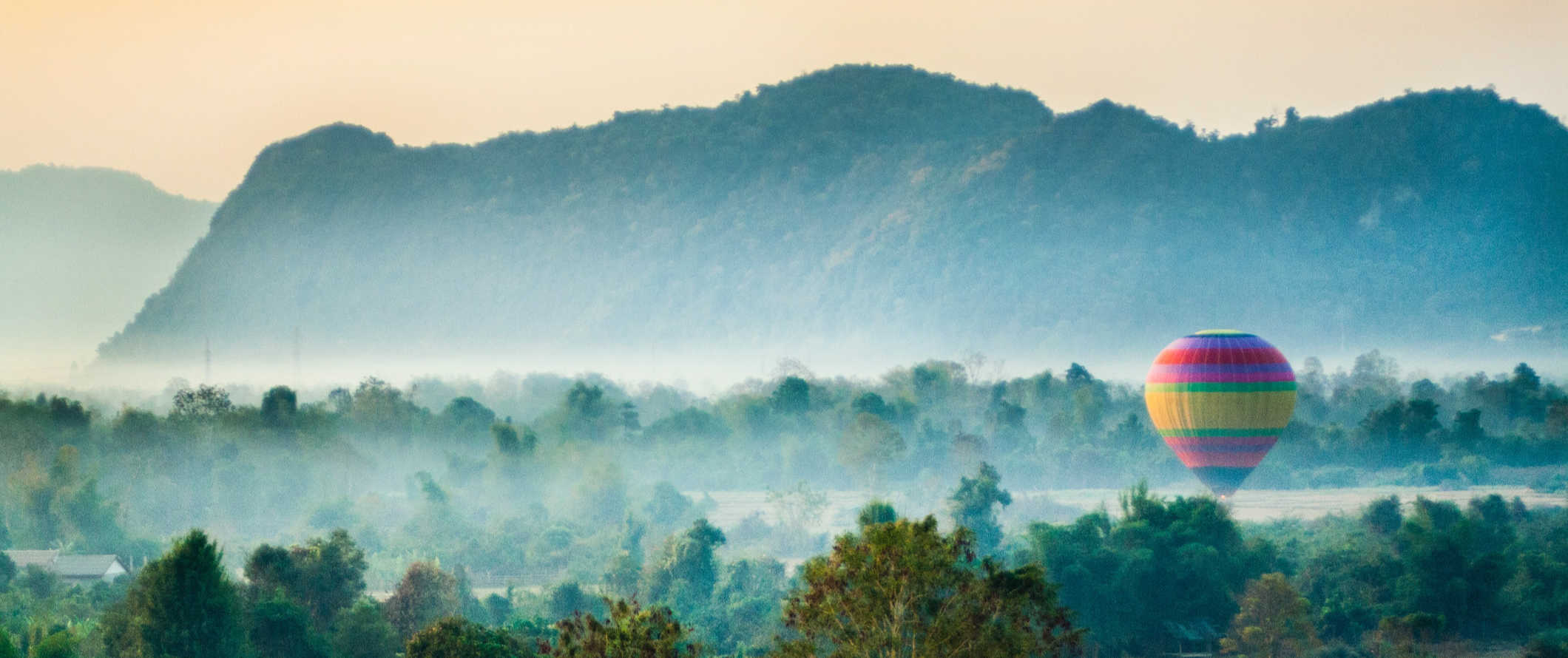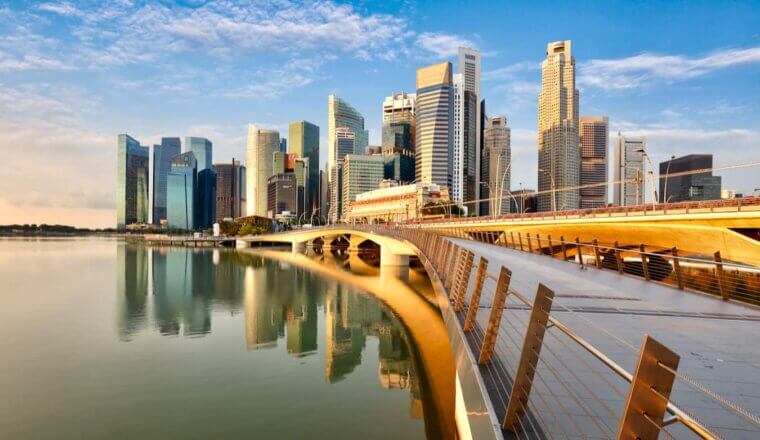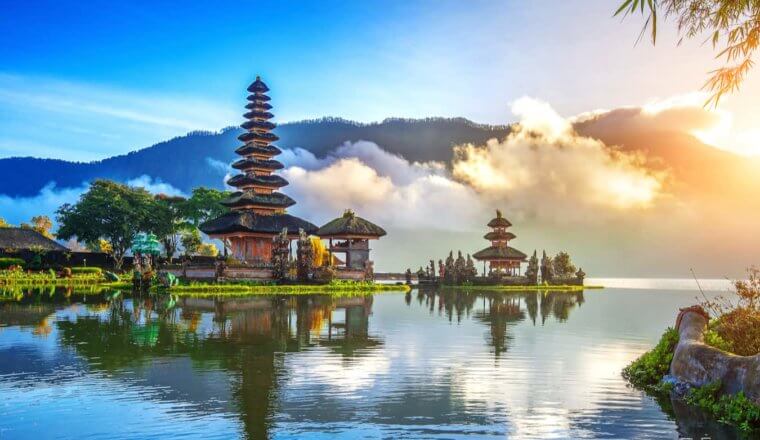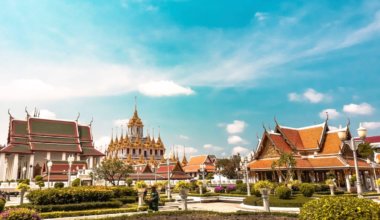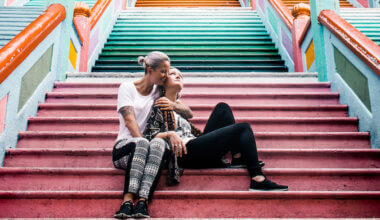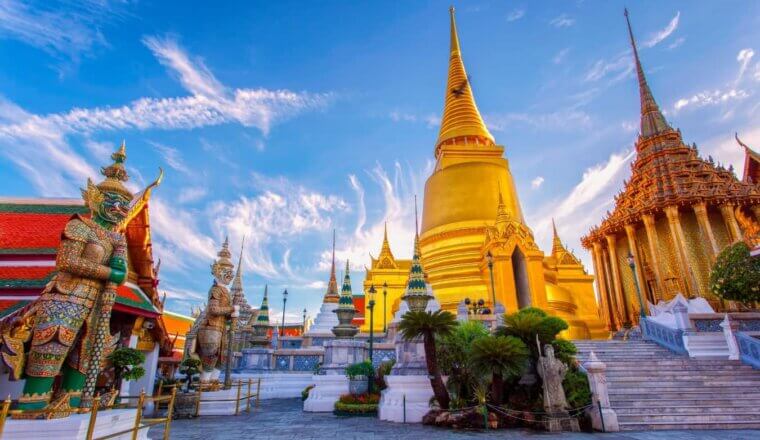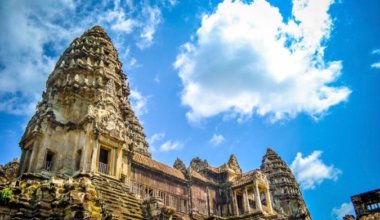Backpackers have been traveling through Southeast Asia since the late 1960s and early 1970s, leaving a well-worn trail around the region.
Starting in beautiful Thailand, the trail makes its way to up-and-coming Laos, through Vietnam, and to the temples of Angkor Wat. It then winds back into Thailand, where people head south to party in the Thai islands before moving down to Malaysia and Singapore.
There are a few variations to the trail, but this is what it mostly covers.
I’ve been visiting this region since 2004 and spent years living in Thailand. I love backpacking Southeast Asia and have written extensively about it as I know it like the back of my hand.
It’s an especially great region for new travelers because it’s easy to travel around, it’s safe, and there are lots of other travelers you can meet. But it’s also perfect for veteran travelers too as there are tons of off-the-beaten-path destinations that the standard backpacker trail doesn’t cover.
In short, Southeast Asia has something for every traveler — and every budget.
This Southeast Asia travel guide will help you travel the region like a pro, ensuring you save money and make the most of your time in this fun, gorgeous, and lively corner of the world.
Table of Contents
Click Here for Country Guides
Top 5 Things to See and Do in Southeast Asia
1. Admire Angkor Wat
One of the greatest human creations in history, the Angkor Wat temple complex is best explored over the course of a few days. The area is a UNESCO World Heritage Site created by the Khmer Empire and absolutely enormous. Temples to visit include Angkor Wat, Bayon Temple which has 216 gigantic stone face carvings, and Ta Prohm. I spent three days here and that simply wasn’t enough. A one-day pass is $37 USD, while a 1-week pass is $72 USD. If you’re here for multiple days, be sure to hire a driver and see some of the more out of the way ruins away from the main temple complex (and the crowds).
2. Explore Bangkok
Bangkok is the hub of travel activity in Southeast Asia. You can get anywhere you want from here. Though I hated it at first, the more I’ve spent time here the more I love it. Bangkok is like an onion whose many layers need to be peeled back. Some things not to miss include the spectacular Bangkok Grand Palace, Wat Pho, Chatuchak Market and Asiatique, and a canal trip on the Chao Phraya River. This is a city for foodies and wild nightlife.
3. Relax on some tropical islands
No visit to Southeast Asia would be complete without a visit to at least one of the thousands of tropical islands in the region. My top five include the Perhentian Islands (Malaysia), Rabbit Island (Cambodia), Ko Lanta (Thailand), and Boracay (Philippines). Lombok Island (Indonesia) has a chill vibe with unspoiled, perfect “desert island” beaches. There’s so many islands to visit. Be sure to add at least one to your trip. The country guides will have more information for you.
4. See Ha Long Bay
Sailing trips to this island-filled bay with stunning emerald waters, limestone formations, and marine life give you an appreciation for the natural beauty in Vietnam. Tours from Hanoi start at around $110 USD for two-day trips and increase from there. I love the colorful grottoes, hanging stalactites, and stalagmites of Surprise Cave (Sung Sot), Fairy Cave (Tien Ong), and Heaven Palace (Thien Cung). Make sure you go with a reputable company though as some of the cheaper boats are less than ideal. If you’d rather just visit for one day, day trips from Hanoi cost $55 USD.
5. Wander Kuala Lumpur
Kuala Lumpur, with its glorious temples and incredible street food scene (this is the best place for Indian food outside of India) is not to be missed. The Petronas Twin Towers are a must-see, and if you don’t mind heights, you should walk across the bridge connecting the two. They stand an awesome 1,500 feet (451 meters) tall! One of my favorite day trips here in KL was to the karst landform 400 million-year-old Batu Caves and temples that house Hindu statues and paintings. For something more down to earth, the Butterfly Park in the Perdana Botanical Garden is the serene home to an incredible 5,000 butterflies, plants, ferns, and flowers and is a beautiful retreat from the bustle of the city.
Other Things to See and Do in Southeast Asia
1. Go jungle trekking
This region of the world is covered in amazing jungles with diverse wildlife, plentiful camping opportunities, and cool waterfalls. The best jungle treks are found in northern Thailand, Western Laos, and Malaysian Borneo (the latter are also the hardest and most intense). Some of my favorites include Danum Valley (Borneo) for its incredible wildlife; Ratanakiri (Cambodia) for its pristine wilderness and thousand-year-old trees; and Pu Luong Nature Reserve (Vietnam). Costs vary but jungle trekking generally costs $30-50 USD per day.
2. Attend the Full Moon Party
The biggest one-night party in the world welcomes up to 30,000 people with a party that stretches until dawn. Cover yourself in glow paint, grab a bucket of booze, and dance the night away with new friends on the island of Ko Phangan in Thailand. As the name would suggest, the party is on the night of the full moon. If you miss it, there’s always the half-moon party, quarter-moon party, and black-moon party. Really, every night is a party on Ko Phangan. Just avoid the flaming jump rope that occurs — I’ve seen people get burned badly!
3. Learn to dive
There are many great dive sites around the region for those interested in underwater exploration. You can learn to dive here at a fraction of what it would cost back home too. Some of the best places are Ko Tao (Thailand), Sipadan (Malaysia), as well as Gili Islands (Indonesia) and Coron, Palawan (The Philippines). A typical diving course is completed in three days. A PADI course typically runs $275 USD in Thailand, including three nights’ accommodation, though at smaller schools you can often negotiate down to $250 USD. Day trips for certified divers start at $165 USD. For information on Ko Tao, check out this blog post.
4. Eat street food in Singapore
Singapore is a foodie’s heaven. Try the hawker stalls of Singapore as well as Little India and Chinatown for some of the best and cheapest food in Asia. If you’re looking for a nice place to sit down and eat, eat at Singapore’s famed restaurants during lunch when restaurants offer discounts, making them a great deal. You’ll also find the most affordable Michelin-starred restaurants here (Tian Tian Hainanese Chicken Rice and Hawker Chan), offering world-class meals for just a couple of bucks!
5. Overload on temples
You can’t turn a corner without seeing a Buddhist temple in this part of the world. You’ll get temple overload at some point but visit as many as you can as each is unique to the country and region of the temple. There are so many places with high concentrations of ornate and beautiful temples. Check out Chiang Mai’s Wat Doi Suthep Temple and hike up the 300 steps to the golden Chedi that’s 600 years old!; Bagan’s Shwesandaw Pagoda from the 11th century with its stunning golden dome; Angkor Wat’s Ta Prohm is covered in iconic vines and enveloped in ancient jungle roots; Hue’s colorful Thien Mu Pagoda is perched atop a lush green embankment; Hoi An’s Quan Cong Temple with incredible Chinese architecture with hand-carved beauty and skill, and Luang Prabang’s Vat Xieng Thong with its golden, canopied roof. Most are free to enter, however, dress codes are enforced (you need to have your shoulders and legs covered).
6. Dive Sipadan
Located off Malaysian Borneo, Sipadan is one of the best dive sites in the world. If you have your dive certificate, make sure you venture out here. I absolutely love this area because it’s teeming with live turtles, diverse cave systems, sharks, dolphins, colorful coral, bright fish, and everything in between. Not a lot of people make it to this part of Malaysia, but it’s worth it to go the extra mile and make your way off the tourist trail a bit. Don’t miss Barracuda Point and The Drop-Off. Keep in mind that only 176 permits to dive at the island are issued each day, costing 140 MYR per person. The resorts on the neighboring islands each get a specific number of permits per day and require divers to stay with them for a few days. So you’ll need to stay at those resorts and dive into the surrounding areas before they can get you a Sipadan permit.
7. Fall in love with Bali
Bali is the most popular destination in Indonesia, and its famous Kuta beach is known for its wild parties and surfing (though I think it’s overrated). However, there is much more to Bali than just wild nights and sun-soaked days. If you’re a thrill seeker, hike up to the top of Mount Batur, an active volcano, for a breathtaking sunrise. Paragliding and white water rafting are also super popular here, as is surfing (it’s an affordable place to learn if you’ve never done it). There are also lots of hot springs to enjoy, the Ubud Monkey Forest (a popular temple and nature reserve home to hundreds of monkeys), and numerous places to scuba dive, including the Liberty wreck and Manta Point.
8. Take in Ho Chi Minh City
Frantic, chaotic, and crazy, Ho Chi Minh City in Vietnam is the embodiment of the controlled chaos that rules Southeast Asia. You can’t quite figure out how this teeming mass of people and cars work together, but it does. Highlights here include touring the tunnels used by the Viet Cong in the 1960s, taking in the view from the Saigon Skydeck, eating your way through the street food scene, and seeing the city’s numerous temples.
9. Admire the sunrise over an Indonesian Volcano
One of the most popular tourist attractions on Java is Mount Bromo and its National Park. Don’t miss out on getting a photo of the smoldering Bromo volcano as it lies surrounded by the almost lunar landscape of the Sea of Sand. Get up early to catch one of the most memorable sunrises of your life. If you’re there in mid-August, you’ll be just in time to see Upacara Kasada, the traditional Hindu ritual of the Tenggerese, a Javanese tribe of the region.
10. Hike in Khao Sok National Park
Located in southern Thailand, Khao Sok National Park is constantly rated as one of the best parks in Thailand, with incredible trekking, camping, limestone karsts, cooling rivers, and a glistening lake. Visit for semi-challenging hikes, tons of wildlife, walking paths, and breathtaking sunsets. Park entrance costs around $6 USD while full-day guided tours are $95 USD. I highly recommend spending at least one night here to get the full experience.
11. Visit Kampot
Most people come to Kampot to enjoy the scenic riverside views, as well as the rolling hills that surround the city. Since you can explore easily enough on foot or by bicycle, Kampot is a great place to slow down and relax. There’s not much to do here but have lazy days by the river, chill, and eat (don’t miss the famous Rusty Keyhole for BBQ!). Don’t miss the pepper farms, as this region of Cambodia is filled with pepper farms where you can learn about the history of the spice, see how it is grown, and pick up what is considered some of the finest pepper in the world. Tours are usually free.
12. Take a cooking class
Food from this region is as varied as the countries themselves and learning how to cook a few dishes is a great souvenir of your time here. Even if you don’t plan to cook back home, you can still spend a day making and eating scrumptious food. Most big cities have cooking schools offering classes of 2-6 hours, often including a trip to the local market beforehand to select ingredients. I absolutely love cooking classes and urge you to take one at least once. They are a fun experience!
13. Take a food tour
If you’d rather eat instead of cook, taking a food tour is a fun way to gain insight into the region’s amazing noodle dishes, fresh seafood, sweets, and street food while learning about the history and culture behind the cuisine. Most major cities in Southeast Asia offer food tours. These include tours around local markets, street stalls, and tours to locally-owned restaurants and cafes where you can sample the local cuisine and connect with a local chef. If you’re nervous about street food, this is a great way to try some in a controlled setting. Tours usually last 2-4 hours and include multiple stops and several different dishes, with prices costing $40-75 USD per person.
14. Visit an elephant sanctuary
While riding an elephant is on many a Southeast Asia bucket list, once you know how much the animals suffer from abuse in order to provide these rides, you might think twice about taking one. An even better way to interact with elephants is to volunteer at or visit the Elephant Nature Park near Chiang Mai in Thailand. It’s a phenomenal place, allowing you to give back to the community and these magnificent animals all at once. After coming here, you will understand why you should NEVER ride an elephant. A one-day visit costs $70 USD.
15. See The Killing Fields
A visit to Choeung Ek, also known as the Killing Fields, may not be the most cheerful way to spend an afternoon, but it makes for an educational and memorable experience. Over 3 million people were killed by Pol Pot’s regime, including countless women and children. I recommend getting a guide so you can really understand what you’re seeing as you explore the area. Also, this horrific tragedy took place less than 50 years ago and is still very present so please be respectful as a visitor. The site is located 10 miles from Phnom Penh. Half-day guided tours start at $66 USD.
16. Swim with Whale Sharks in Donsol
If you’re in the Philippines, check out the Donsol Whale Shark Interactive Ecosystem Project because there are not many experiences quite as adrenaline-inducing as swimming with a whale shark for the first time in crystal waters. These incredible creatures are around 45 feet (14 meters) long and yet incredibly gentle and curious. I loved floating at the surface being able to look below and see them slowly swim below me. Get some people together and rent a boat for a half day, explore the area, and go ‘shark-seeing’ for a good cause.
For a ton more information, visit my country specific travel guides for more detailed information on each place:
Southeast Asia Travel Costs
Accommodation – Accommodation in Southeast Asia is really cheap, making it the perfect place to travel if you are on a budget. Hostels are plentiful, as are budget guesthouses and hotels. It’s also very cheap to splash out here if you’re in need of some luxury.
Generally, you can find hostel dorm rooms for as little as $6-8 USD in Cambodia and $3-6 USD in Laos. In Thailand, 4-6-bed dorm rooms are $8-12 USD, while in Vietnam you can expect to pay $5-7 USD. In Indonesia, prices range between $5-10 USD for a 4-6-bed dorm room. Expect to pay at least $15-20 per night for a private room with air conditioning. Free Wi-Fi is standard in most hostels, free breakfast is common, and many hostels even have pools. In more remote areas, hot water isn’t common so make sure to check in advance if that’s an issue for you.
Simple guesthouses or bungalows throughout Southeast Asia generally cost $12-20 USD per night for a basic room with a fan (sometimes air conditioning) and hot water. If you want something nicer that includes a more comfortable bed and a TV, expect to pay $25-35 USD per night.
For backpackers, budgeting around $10 USD per night for accommodation is pretty safe no matter where you go in Southeast Asia. If you’re looking for a higher-end hotel room with more amenities, expect to pay $20-50 USD per night for a room. Anything over that is luxury territory.
Camping is available in certain areas, usually for just a few dollars per night for a basic tent plot without electricity. However, this is about the same price as hostels so it’s not really any cheaper.
Food – While each country’s cuisine varies, overall, Southeast Asian food is aromatic, spicy, and flavorful. Typical spices and herbs include garlic, basil, galangal, cilantro, lemongrass, kaffir lime leaves, chilies, and fish sauce. No matter what region you’re in, you can expect to find a variety of curries, salads, soups, noodle dishes, and stir-fries.
Rice and noodles are central to Southeast Asian food, while the meat is usually pork, chicken, fish, or seafood, which is everywhere on the islands and coastal areas.
While traveling Southeast Asia, street food is the most popular food and cheapest option. On average, these meals cost $1-5 USD. You find these stalls throughout this region lining most streets and every market. They are ubiquitous in the region. In Singapore, street food (from “hawker stands” as they’re known there) costs around $4-5 USD for a meal. Even if you go into small local restaurants, the price doesn’t increase that much.
Food that costs $2 USD at a street stall generally only costs $4-6 USD at a local restaurant. If you went into a restaurant in Thailand, you’d pay around $3-4 USD for a pad Thai that would have cost $1-2 USD on the street.
In Cambodia, street food is around $1-2 USD, while restaurants charge around $3-5 USD for a dish like amok (a coconut milk dish) or luc lac (pepper gravy beef).
Western meals, including burgers, pizza, and sandwiches usually cost around $7-10 USD. But these generally aren’t that great. If you want something that actually tastes as it does back home, expect to spend at least $10-12 USD for your meal.
While cheap, alcohol can take a bite out of your budget if you’re not careful. Those $1-2 USD beers add up! Wine and cocktails are more expensive, generally around $3-5 USD. A cappuccino is typically around $2 USD. Bottled water is plentiful and costs less than $1 USD.
There’s a growing cutting-edge foodie scene in the region and, if you want to splurge, you can do so on some really good meals. Big cities like Bangkok, KL, and Singapore, all have world-class Michelin star restaurants as well some incredible fusion restaurants.
Since dining out is so cheap in the region, there’s no point in grocery shopping unless you’re looking to get some pre-made salads or fruits. Additionally, a general lack of kitchens in most hostels and hotels makes it difficult to cook even if you wanted to. If you do purchase your own groceries, expect to spend around $25 USD per week for basic groceries like local produce, rice, and some meat (while avoiding expensive imported items like cheese and wine).
For more detailed price breakdowns and specific food recommendations, visit my country specific guides.
Backpacking Southeast Asia Suggested Budgets
On a backpacker budget of $45 USD per day, you can stay in hostel dorms, eat out at local markets and street stalls, limit your drinking, do mostly free activities, minimize paid activities, and use public transportation to get around. You’re not going to be able to splash out but you’ll be able to live the typical backpacker experience without really stressing over expenses.
On a mid-range budget of $85 USD per day, you can stay in budget hotels or private hostel rooms, eat more restaurant meals, do more paid activities like cooking classes, take some taxis, and enjoy a few more drinks. You won’t live large, but you won’t be missing out either.
On an upscale budget of $150 USD or more per day, you can stay in nicer hotels with more amenities, eat out as much as you want, do more paid tours including private tours, hire a driver, fly between destinations, and basically do whatever you want. The sky is the limit with this kind of budget!
Southeast Asia Travel Guide: Money-Saving Tips
Backpacking Southeast Asia is cheap. There’s little opportunity to spend a lot of money since everything is already so inexpensive unless you intentionally are trying to splash out on fancy meals and high end hotels. The two reasons why most travelers end up overspending is that they eat a lot of Western food and drink way too much. If you want to save money while traveling in this part of the world, cut down on your drinking and skip the Western food. While country guides have more specific ways to save money, here are some general ways to save money in Southeast Asia:
- Stay with a local – Accommodation is cheap in Southeast Asia but nothing’s cheaper than free! Use Couchsurfing to stay with locals who have extra beds and couches for free. You’ll also meet great people who can show you around and share their insider tips and advice.
- Book tours and day trips as a group – You have more negotiation power when you’re with a group of people buying multiple spots or tickets. Traveling alone? Meet a friend at a hostel and see if they want to join the same tour as you. I’ve met some great friends over the years doing this and highly recommend it.
- Don’t book in advance – Don’t book any tours or activities before you get to your destination. They’ll be much cheaper when you arrive as you’ll be able to negotiate a lower price as you’ll find companies are often offering the same tour and competing. Anything you see online is more expensive than you need to pay!
- Eat on the street – The street food is the best food. The food is the best and cheapest you’ll find. It’s a great way to try new foods and get to chat with locals as well. This is where locals eat so if you want insight into local culture, good food, and savings, eat the street food. Look for where locals are eating to ensure that it’s safe to eat.
- Bargain hard – Nothing is ever at face value here. Bargain with sellers as most of the time, the price they’ve quoted is way higher. There’s a haggling culture in the region so play the game and save some money. It’s important not to convert it in your head to your own currency because it will usually sound cheap even though you might still be getting ripped off. You’ll never get the local price, but you might come close!
- Minimize your drinking – Drinks really add up. Even with cheap drinks, if you’re not aware, you’ll end up spending more money on beer than on food and accommodation. If you want to drink, head to the supermarkets, drink at the hostel, or check out the local happy hours.
- Pack a water bottle – A water bottle with a purifier comes particularly in handy in Southeast Asia since you can’t usually drink the tap water. Save money and thousands of plastic bottles and get a bottle that can purify the tap water for you. My preferred bottle is LifeStraw as it has a built-in filter that ensures your water is always safe and clean.
Where to Stay in Southeast Asia
I’ve been traveling Southeast Asia since 2005 and have stayed in hundreds of places. Here are some of my favorite places to stay in Southeast Asia:
Cambodia
- The Siem Reap Pub Hostel (Siem Reap)
- Onederz Siem Reap (Siem Reap)
- Mad Monkey Siem Reap (Siem Reap)
- Onederz Sihanoukville (Sihanoukville)
- Monkey Republic (Sihanoukville)
- Onederz Phnom Penh (Phnom Penh)
- Sla Boutique Hostel (Phnom Penh)
- The Magic Sponge (Kampot)
Laos
- Indigo House Hotel (Luang Prabang)
- Sa Sa Lao (Luang Prabang)
- Sanga Hostel (Pakse)
- Nana Backpackers Hostel (Vang Vieng)
- Dream Home Hostel (Vientiane)
Malaysia
- Traveller Bunker Hostel (Cameron Highlands)
- De’Native Guest House (Cameron Highlands)
- Kitez Hotel & Bunks (Kuala Lumpur)
- Sunshine Bedz Kuala Lumpur (Kuala Lumpur)
- Ryokan Muntri Boutique Hostel (Penang)
Thailand
- Mad Monkey Hostel (Bangkok)
- D&D Inn (Bangkok)
- Kodchasri B&B (Chiang Mai)
- The Royal Guest House (Chiang Mai)
- Green Leaf (Khao Yai)
- Lonely Beach Resort (Ko Chang)
- The Sanctuary (Koh Phangan)
- Na-Tub Hostel (Koh Phangan)
- Pineapple Guesthouse (Phuket)
Singapore
Vietnam
- Under the Coconut Tree Guesthouse (Hoi An)
- Fuse Beachside (Hoi An)
- Pretty Backpackers House (Da Lat)
- Hanoi Old Quarter Hostel (Hanoi)
- Luxury Backpackers Hostel (Hanoi)
- The Hideout (HCMC)
- City Backpackers Hostel (HCMC)
For more places to stay, check out our countries guides to each country: Thailand, Laos, Vietnam, Singapore, Malaysia, Cambodia, and Indonesia.
How to Get Around Southeast Asia
Public transportation – Public transportation costs from a few pennies to a few dollars, with Singapore and Malaysia offering the most comprehensive public transportation systems. In Thailand, local buses cost around $0.25 USD per trip, while the Metro and Skytrain in Bangkok cost $0.50-1.50 USD per trip. In Cambodia, a bus ticket in Phnom Penh costs just $0.40 USD per ride.
Major cities generally have subway systems but mostly you’ll be using the bus or shared taxis to get around.
Tuk-tuks (small, shared taxis with no meter) are available around much of the region and require a bit of haggling. They usually have 3-6 seats and generally cost more than public transportation but are faster. To find a reputable driver, ask your accommodation as they usually know someone. Tuk-tuk drivers can often be hired for the day for a discounted rate (this is what a lot of people do to visit the Killing Fields and Angkor Wat in Cambodia, for example).
Taxi – Taxis in the region are generally safe, though it’s not uncommon to have to haggle. Scams to rip you off aren’t uncommon either, so always ask your accommodation to call you a taxi whenever possible so you know you’ll get a reputable company.
In Singapore and Indonesia, taxi drivers do put on the meter. In Bangkok, you can get taxi drivers to use the meter, but if you’re hailing one in a tourist area, he might try to avoid using it. In Vietnam, the meter is sometimes rigged, but if you can get a reputable company like Mai Linh, you won’t have any problems.
Ridesharing – Grab, DiDi, and Gojek are Asia’s answer to Uber. They work the same way: you hire a driver to take you somewhere via the app, and you can pay via the app or in cash. It’s often more affordable than a regular taxi, though drivers are a bit unreliable as the practice is not as widespread here as in other parts of the world.
Just keep in mind that some drivers are driving motorcycles so be sure to double check what kind of vehicle is picking you up if you don’t want to ride on the back of one.
Bus – The easiest and cheapest way to travel around Southeast Asia is by bus. The backpacker trail is so worn that there is a very well-established tourist bus system to take you anywhere. Buses costs vary between $5-25 USD for a 5-6 hour journey. Overnight buses cost $20-35 USD depending on distance (they often have reclining seats so you can get a decent sleep).
You can check ticket prices and book tickets for all the different bus companies across Southeast Asia at 12go.asia.
Train – Train service is limited in the region and not something to really consider when you travel Southeast Asia. You can take a train up and down the coast of Vietnam and there’s some limited scenic rails in Malaysia. Thailand is the only country that has an extensive train system that lets you travel all its regions (and onward to Singapore) from Bangkok.
The train prices in Southeast Asia are determined by distance and class. Night trains with sleeper cars are more expensive than day trains. The night train to Chiang Mai from Bangkok takes twelve hours and costs $27 USD for a sleeper seat. However, that same train during the day is $8-9 USD. In Vietnam, trains run up and down the coast and cost $60 USD from Hanoi to Ho Chi Minh City.
Flying – The cost of flying around Southeast Asia has come down in recent years due to the rise of low-cost airlines. Scoot, Jetstar, and AirAsia are the biggest. Nok Air has a lot of flights within Thailand, and VietJet Air is popular in Vietnam. Lion Air serves Indonesia, but its safety record is really spotty and I personally would not fly them. If you book early, you can save on fares, as most of the airlines offer deeply discounted fare sales all the time, especially Air Asia.
Just make sure that the airport these budget airlines fly into isn’t too far out of your way (transportation from the secondary airport sometimes negates the savings from using the budget airline itself).
Also, keep in mind that you usually must pay to check your baggage on these cheap flights. If you wait to pay for your luggage at the gate, you end up paying almost double. Travel carry-on only to avoid this added cost.
All in all, I only recommend flying if you are pressed for time or find a super cheap deal. Otherwise, stick to the bus.
Hitchhiking – Hitchhiking in Southeast Asia is safe, though popularity of the practice varies by country (it’s more common in Malaysia, but not so much in Cambodia). Dress respectably, smile while making eye contact with drivers, and use a cardboard sign to tell people where you’re headed. Be prepared for long bouts of no pick-ups, especially if you’re traveling through more rural areas. Pack plenty of water and food. Also, make sure the people picking you up understand you’re hitchhiking and not flagging down a taxi.
Hitchwiki is a great resource for hitchhiking tips.
Car rental I don’t recommend renting a car in Southeast Asia. Rental cars are expensive ($40 USD per day or more) and the roads here are in poor shape. I would never drive around the region.
This post discusses getting around Southeast Asia in-depth if you want more information.
When to Go to Southeast Asia
The best time of year to visit Southeast Asia is from November to April when temperatures are milder (though temperatures vary drastically by region). It may be mild in Thailand in January and hot in Malaysia but in Northern Vietnam, it’s cold! Also, one of the biggest mistakes people make is not taking into account the rainy season. In some cases it won’t make a big difference but definitely does if it’s a beach trip.
In Indonesia, the best time to visit is April to October. Temperatures average 24-30ºC (75-86ºF), and the weather is mostly dry. July to September is the peak holiday season and when you can expect to pay the highest rates. December to February is the rainy season.
In Malaysia, January-March and June-September are the best time to visit, as these months have the lowest average rainfall. It is still hot and humid during this time though. The rainy season is from October to December. Singapore’s climate/weather is much like Malaysia’s.
In Vietnam, the weather varies by region. In Central Vietnam (including Hoi An and Nha Trang), January-May is the best time to visit because it is dry and the temperatures average 21-30°C (70-86°F). June to August is also a decent time to visit. If you want to stick around Hanoi, March to April is great, or October to December (for mildest temperatures). The rainy season is May-September.
Thailand has three seasons: hot, hotter, and hottest. It’s always warm, though the weather is nicest between November and February (which is also peak tourist season). Bangkok is “coolest” and driest during this time (but still averaging a hot 29°C/85°F each day). April and May are the hottest months, and the rainy season is June-October. The gulf islands get pretty rainy from August to December.
The dry season in Cambodia is from November-May and the cool season is from November-February (and when most people visit). Temperatures during this time are still high, but humidity is lower. Laos has the same cool season as Cambodia, with the dry season running from November-April.
In the Philippines, it’s mostly warm all year long with an average daily high of 26°C (80°F). There are rainy and dry seasons and temperatures are hot and dry from March-May and cooler December-February. The best time to visit is between January-April when it’s less humid. Monsoon Season is July-October.
For more information on when to go to places, visit the specific country guides.
How to Stay Safe in Southeast Asia
Southeast Asia is an incredibly safe place to backpack and travel — even if you’re traveling solo and even as a solo female traveler. Violent crime is super, duper rare. Petty theft (including bag snatching) is the most common type of crime in Southeast Asia, especially around popular tourist landmarks. Always keep your valuables out of reach on public transportation and in crowds just to be safe. Never leave your valuables unattended while at the beach and always keep a hold of your purse/bag when out and about as bag snatching is common.
That said, outside touristy areas, theft is really rare. Heck, it’s pretty rare in touristy areas too! But a little vigilance goes a long way and it’s better to be safe than sorry.
There are some common scams around that you’ll want to be aware of, such as the motorbike scam. This involves a bike rental company trying to charge you for damage to the bike that you didn’t cause. To avoid this, always take photos of your rental before you leave so you can protect yourself from baseless claims.
Another common scam involves a tuk-tuk driver taking you somewhere you didn’t want to go in hopes you’ll buy something from the shop/restaurant he dropped you off at (he gets a commission if you do). Simply refuse to buy anything and demand to go back to where you were — or find another driver.
For other common travel scams, read this post about major travel scams to avoid in the region.
Solo female travelers should feel safe here, though it’s generally a good idea to avoid walking around alone at night just to be safe. It’s always a good idea to carry some extra cash to get home in a taxi if you need to. Additionally, always keep an eye on your drink at the bar and never accept drinks from strangers. Be sensible when it comes to dating while traveling and meeting people in public places. As I’m not a woman, please check out some solo female travel blogs to get the best insight.
Overall, the people who get in trouble here tend to be involved with drugs or sex tourism. Avoid those two things and you should be fine. Keep in mind that it’s not always obvious how old someone is or if they’re a sex worker so be mindful when getting involved in romantic interactions. Also, penalties for drug use in this region are stiff so even if you’re here to party, skip the drugs.
Always trust your gut instinct. Make copies of your personal documents, including your passport and ID. Forward your itinerary along to loved ones so they’ll know where you are.
For more in-depth coverage of how to stay safe in Southeast Asia, check out this post that answers some frequently asked questions and concerns.
The most important piece of advice I can offer is to purchase good travel insurance. Travel insurance will protect you against illness, injury, theft, and cancellations. It’s comprehensive protection in case anything goes wrong. I never go on a trip without it as I’ve had to use it many times in the past. You can use the widget below to find the policy right for you:
Southeast Asia Travel Guide: The Best Booking Resources
These are my favorite companies to use when I travel. They consistently have the best deals, offer world-class customer service and great value, and overall, are better than their competitors. They are the companies I use the most and are always the starting point in my search for travel deals.
- Skyscanner – Skyscanner is my favorite flight search engine. They search small websites and budget airlines that larger search sites tend to miss. They are hands down the number one place to start.
- Hostelworld – This is the best hostel accommodation site out there with the largest inventory, best search interface, and widest availability.
- Agoda – Other than Hostelworld, Agoda is the best hotel accommodation site for Asia.
- Booking.com – The best all around booking site that constantly provides the cheapest and lowest rates. They have the widest selection of budget accommodation. In all my tests, they’ve always had the cheapest rates out of all the booking websites.
- Get Your Guide – Get Your Guide is a huge online marketplace for tours and excursions. They have tons of tour options available in cities all around the world, including everything from cooking classes, walking tours, street art lessons, and more!
- SafetyWing – Safety Wing offers convenient and affordable plans tailored to digital nomads and long-term travelers. They have cheap monthly plans, great customer service, and an easy-to-use claims process that makes it perfect for those on the road.
- LifeStraw – My go-to company for reusable water bottles with built-in filters so you can ensure your drinking water is always clean and safe.
- Unbound Merino – They make lightweight, durable, easy-to-clean travel clothing.
Get the In-Depth Budget Guide to Thailand!
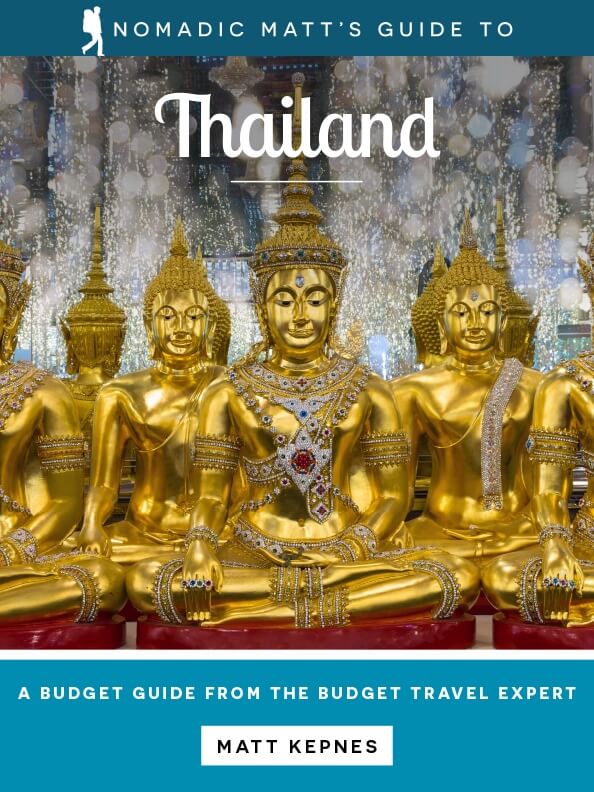
My detailed 350+ page guidebook is made for budget travelers like you! It cuts out the fluff found in other guidebooks and gets straight to the practical information you need to travel around Thailand. You’ll find suggested itineraries, budgets, ways to save money, on and off-the-beaten-path things to see and do, non-touristy restaurants, markets, bars, safety tips, and much more! Click here to learn more and get your copy today.
Southeast Asia Travel Guide: Related Articles
Want more info? Check out all the articles I’ve written on Southeast Asia travel and continue planning your trip:
